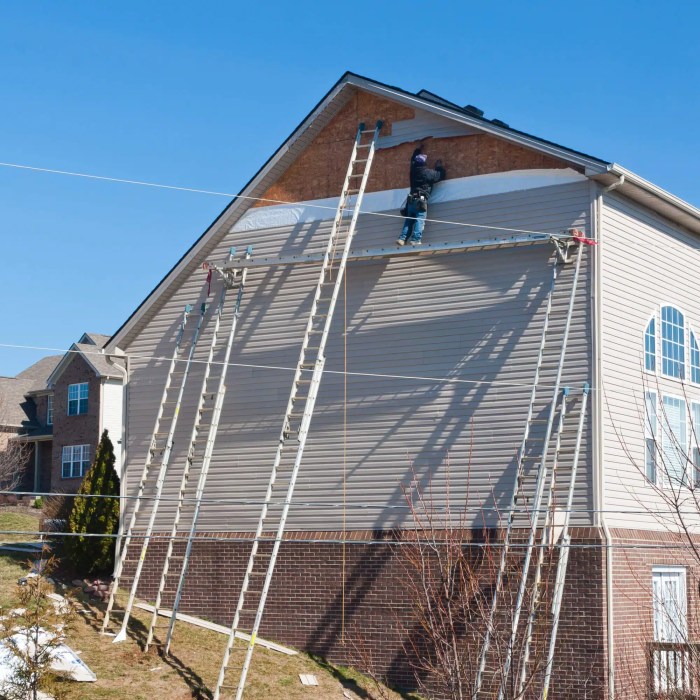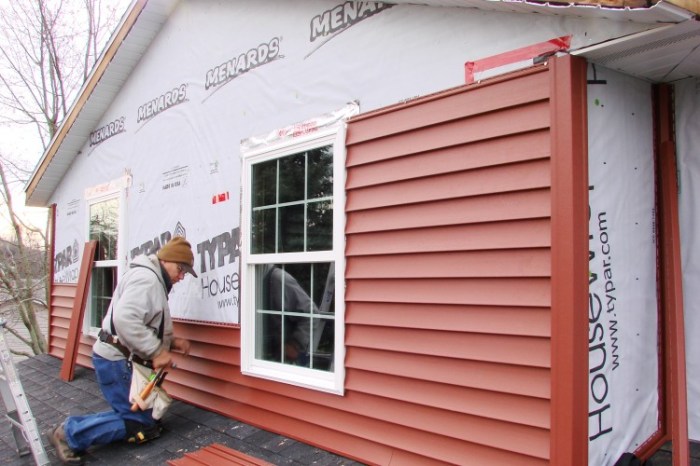A Comprehensive Guide to Home Siding Installation
Embarking on the journey of home siding installation opens up a world of possibilities and choices, each leading to a unique transformation of your living space. From selecting the right materials to understanding the installation process, this guide will equip you with the knowledge needed to make informed decisions for your home.
Types of Home Siding Materials
When it comes to home siding materials, there are several options to choose from based on durability, maintenance, and aesthetic appeal.
Vinyl Siding vs. Wood Siding
Vinyl siding is a popular choice for homeowners due to its low maintenance and cost-effectiveness. It is durable, resistant to rot and insects, and comes in a variety of colors and styles. On the other hand, wood siding offers a classic and natural look that can enhance the curb appeal of a home.
However, wood siding requires more maintenance, such as painting or staining, and is susceptible to rot and insect damage if not properly maintained.
Fiber Cement Siding Benefits over Aluminum Siding
Fiber cement siding is known for its durability and low maintenance requirements. It is resistant to rot, fire, and insects, making it a long-lasting option for homeowners. Additionally, fiber cement siding can mimic the look of wood or stucco without the same level of maintenance.
In comparison, aluminum siding is lightweight and easy to install, but it may dent easily and is not as resistant to impact or fire as fiber cement siding.
Home Siding Installation Process

When it comes to installing home siding, proper preparation and technique are crucial for a successful outcome. Here is a detailed guide on the steps involved in preparing a house for siding installation, how to measure and cut siding materials accurately, and the importance of weatherproofing during the process.
Preparing the House for Siding Installation
- Remove any existing siding or trim from the house.
- Inspect the exterior walls for any damage, rot, or mold that needs to be repaired before installation.
- Clean the walls thoroughly to ensure a smooth surface for the new siding to adhere to.
- Apply a weather-resistant barrier or house wrap to protect the walls from moisture.
Measuring and Cutting Siding Materials
- Measure the length and height of each wall to determine the amount of siding needed.
- Use a chalk line to mark where each piece of siding will be installed.
- Use a circular saw or siding cutter to cut the siding to the correct size.
- Ensure each piece is cut accurately to fit snugly against the wall and any windows or doors.
Importance of Weatherproofing
- Proper weatherproofing is essential to protect your home from water damage, mold, and rot.
- Make sure to seal all seams and joints in the siding to prevent water infiltration.
- Use flashing around windows, doors, and corners to divert water away from the house.
- Choose a siding material that is durable and weather-resistant to ensure longevity and minimal maintenance.
Cost Considerations
When it comes to home siding installation, cost considerations play a significant role in decision-making. Understanding the breakdown of costs associated with siding installation can help homeowners make informed choices that align with their budget and preferences.
Average Costs of Home Siding Installation
- On average, the cost of home siding installation ranges from $6,000 to $15,000 for a typical single-story home.
- The specific cost can vary depending on factors such as the size of the home, the type of siding material used, and the labor costs in your area.
- Additional costs may include removing old siding, repairing any underlying issues, and finishing touches like painting or sealing.
DIY vs. Professional Installation
- While DIY siding installation can be cost-effective in terms of labor expenses, it requires specialized tools, skills, and knowledge to ensure proper installation.
- Professional installation, on the other hand, may come at a higher upfront cost but can save time and potential mistakes in the long run.
- Consider your own expertise and available time when deciding between a DIY approach and hiring professionals for your home siding installation.
Impact of Siding Materials on Installation Costs
- Vinyl siding is one of the most cost-effective options, with average installation costs ranging from $3 to $7 per square foot.
- Fiber cement siding tends to be more expensive, with installation costs averaging between $5 to $12 per square foot.
- Wood siding can vary widely in cost, depending on the type of wood chosen, with installation costs ranging from $6 to $15 per square foot.
Maintenance and Upkeep
Regular maintenance is essential to ensure that your home siding remains in good condition and continues to protect your house effectively. By performing routine maintenance tasks and inspections, you can prevent costly repairs and prolong the lifespan of your siding.
Additionally, keeping your siding clean and well-preserved can enhance the overall appearance of your home.
Importance of Regular Inspections
Regular inspections are crucial for the early detection of any damage or issues with your home siding. By identifying problems such as cracks, warping, or mold growth early on, you can address them promptly and prevent further damage to your siding and the underlying structure of your home.
Cleaning and Preserving Different Siding Materials
- Vinyl Siding:Clean vinyl siding with a mixture of water and mild detergent using a soft brush or cloth. Rinse thoroughly to remove any soap residue. Avoid using harsh chemicals or abrasive materials that can damage the surface.
- Wood Siding:Regularly inspect and repair any damage to wood siding, such as rot or insect infestations. Clean wood siding with a solution of water and mild detergent, and consider applying a protective sealant to prevent moisture damage.
- Fiber Cement Siding:To clean fiber cement siding, use a solution of water and mild detergent with a soft brush. Avoid using high-pressure washers, as they can damage the siding. Inspect for any cracks or chips and repair them promptly.
- Aluminum Siding:Clean aluminum siding with a solution of water and mild detergent, using a soft brush or cloth. Inspect for any dents or scratches that may need to be addressed. Consider applying a protective coating to prevent oxidation.
Closing Summary

As we conclude this discussion on home siding installation, remember that the key to a successful project lies in thorough preparation, meticulous execution, and regular maintenance. By following the guidelines Artikeld here, you can enhance the beauty, durability, and value of your home for years to come.
General Inquiries
What are the benefits of fiber cement siding over aluminum siding?
Fiber cement siding offers superior durability, fire resistance, and low maintenance compared to aluminum siding.
How do different siding materials impact overall installation costs?
Materials like vinyl siding tend to be more cost-effective than wood siding due to lower installation and maintenance costs.
What maintenance tasks are required to keep home siding in good condition?
Regular cleaning, inspections for damage, and prompt repairs are essential for maintaining the integrity of home siding.